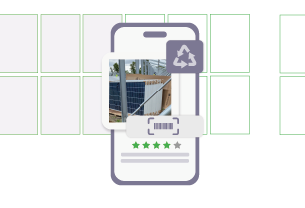Planning a new solar project? Need to know more about choosing a solar tracker system? Wondering what the difference is between fixed tilt, single-axis and dual-axis? In this blog post, we explain the types of tracker systems and why they are increasingly being adopted for new construction projects.
![]()
What is a solar tracker system?
A solar tracker system is an innovative way of mounting solar panels. The technology allows solar panels to follow the sun’s position throughout the day. As a result, they are always at the best angle to absorb as much solar energy from the sun as possible. A good question: Why would this technology not be on every solar plant? At Above we are seeing an increase in the adoption of movable mounting tracker systems for new solar construction projects globally. There are benefits to both fixed and moving mounting structures, so it depends on the solar project as to what you choose.
Fixed, Single and Dual
Some solar plants have panels that are mounted to the structure at a fixed angle. These are called fixed-tilt solar mount systems. Fixed solar mount systems are simple structures and so don’t require as much maintenance as moving structures.
Single-axis tracker systems are set at an inclination angle and track the sun from its rise in the east, to when it sets in the west, allowing them to increase yield by 20% and more in certain conditions [1], according to SolarBuild Mag.
Dual-axis trackers go that one step further, they track the sun’s position perfectly using both their X and Y axes. Dual-axis trackers can generate 40% more energy [2] than fixed mounting systems in the same location.
![]()
Why are trackers a growing trend in solar construction?
Solar tracker systems have gained traction within ground-mounted solar installations due to their ability to improve energy yields. The cost difference compared with fixed-tilt systems has significantly narrowed in recent years making trackers more appealing. Fixed-tilt mount systems are simpler and cheaper, however, the increase in energy generation of tracker systems often offsets the cost difference in a short space of time.
Today’s smart tracker technologies integrate advanced algorithms, enabling trackers to not only align the panels for optimal sun but also minimise shading from neighbouring panels. Compared with early tracker systems, newer technologies can withstand colder temperatures, presenting an advantage for colder regions like Scandinavia. Some systems on the market even have defence responses to extreme weather such as hailstones, which is of great value for some regions in North America.
What are the pros and cons of tracker systems?
There are several factors to consider before choosing a solar tracker system for your construction project and solar plant. You can select tracker system solutions based on the climatic zone, location topography and expected wind loads on site.
Solar trackers allow the solar panels to generate more power than a fixed-angle plant of the same configuration. It is widely known that single and dual-axis trackers offer a lower Levelised Cost Of Electricity (LCOE). PV Magazine highlights “The levelized cost of electricity (LCOE) for agrivoltaic bifacial systems based on single-axis trackers is 23% lower than that of agrivoltaic bifacial facilities built on fixed structures, a new study from KU Leuven in Belgium has shown.” [3] While this technology boasts numerous advantages, it may not be suitable for every terrain. Steep slopes and heavily undulating ground present challenges. For this reason, providers offer guidance on the system’s tolerance levels for such terrains. Tracker systems have more moving parts than fixed systems, which means more consideration when planning operational and maintenance activities.
Wind load is a very important factor to consider when developing a solar plant, especially when tracker systems are used. Powerful winds can cause significant damage to the structure and modules as well as other components. The risk is high if the proper considerations are not made or when utilising solutions that are not properly engineered. Nowadays, top-tier global tracker manufacturers have developed a well-engineered solution. This includes strategies to safeguard the inner rows of the array, thanks to the outer rows that act as a wind barrier and shield. To ensure their effectiveness, the outer row structures are built with stronger components with thicker steel compared to the inner rows. In 2023, recent research has been made on a method to estimate the maximum speed that single-axis trackers can effectively handle. [4]
Digital tools for visually managing tracker systems
As solar sites grow, more companies are using software and aerial data to track the condition of solar components. Aerial construction monitoring is a valuable tool in the industry. The technology aids construction managers in detecting mistakes early on. Using digital maps you can look at construction over time and make a note of any structures deviating from the solar plant design. At first glance, this may seem to be irrelevant but when going back to the wind considerations, accurate records have a massive impact on site safety and operation. Mobile tools also excel in aiding solar activities, recording and automatically uploading large volumes of visual data collected onsite.
“We are working on solar plants that produce gigawatts of energy. The biggest one in the Southern Hemisphere covers around 900 hectares (3.5 sq. mi) with 800,000 solar panels. You can’t manage the maintenance of a site like that with a spreadsheet.” Will Hitchcock, CEO & Founder of Above.
We hope you found this useful when choosing a solar tracker system. Tracker systems are a valuable investment for large-scale solar installations. They can generate more electricity and optimise power generation efficiency. Stay tuned for part two, where we will explore the digital tools available to make the most of this investment from topographic surveys to condition monitoring.
Other publications referenced in our blog for further reading, check out:
[1] Overview of the dual-axis solar tracker market. By Charles W. Thurston, April 5, 2023
[2] Overview of the dual-axis solar tracker market. By Charles W. Thurston, April 5, 2023
[4] Novel mathematical model to assess wind stability of solar trackers By PV Magazine


